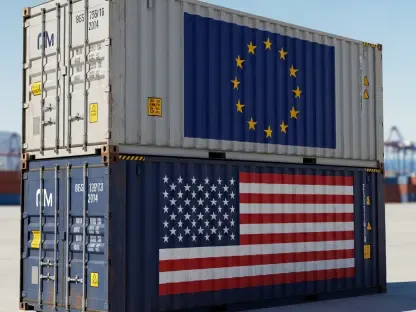Overview of the Tech and Policy Intersection
The digital landscape today stands at a critical juncture where technology, government policy, and civil rights collide with profound implications for society at large. Major tech giants like Apple and Google, controlling vast ecosystems through their app stores, wield immense power over what tools and information reach millions of users. This gatekeeping role has thrust them into the center of a heated debate as the removal of ICE-tracking apps—tools designed to alert immigrant communities to Immigration and Customs Enforcement activities—has sparked outrage and concern. Under pressure from the Trump administration, these companies have made decisions that highlight the delicate balance between complying with governmental demands and safeguarding individual freedoms.
This intersection is not merely a technical issue but a societal one, as mobile applications increasingly shape political discourse and community safety. For vulnerable populations, such as immigrant groups, these digital tools can mean the difference between security and deportation. The unfolding controversy over ICE-tracking apps serves as a stark reminder of how technology can both empower and endanger, setting the stage for a deeper examination of the responsibilities tech companies bear in navigating this complex terrain.
Detailed Analysis of the ICE-Tracking App Controversy
Emergence and Purpose of ICE-Tracking Tools
ICE-tracking apps, such as ICEBlock, emerged as grassroots solutions to protect immigrant communities from unexpected raids and enforcement actions. Developed with the intent of providing real-time alerts about ICE agent presence, these tools became lifelines for many, offering a digital shield against sudden detentions. Their creators, often motivated by personal or communal ties to immigration issues, sought to empower users with information to navigate an often hostile environment.
The significance of these apps cannot be overstated, with platforms like ICEBlock reportedly amassing over a million users. This widespread adoption underscores a critical need for accessible, immediate data in communities living under constant threat. As digital sentinels, these applications represented a new frontier in community organizing, leveraging technology to foster safety and awareness where traditional resources fell short.
Tech Giants’ Role and Market Dominance
Apple and Google dominate the mobile app ecosystem, commanding significant market share through the App Store and Google Play. Industry data indicates that together, they control over 95% of the global mobile operating system market, with billions of app downloads annually shaping user behavior and access to information. Their platforms are not just marketplaces but arbiters of content, deciding what tools are permissible under their stringent guidelines.
Historically, both companies have faced dilemmas in balancing user rights with governmental pressures. Instances such as app removals in China to comply with local censorship laws reveal a pattern of prioritizing legal compliance over unrestricted access. This dynamic places them in a precarious position when confronted with demands from authorities, as seen in the recent ICE-tracking app controversy, where their influence directly impacts the availability of critical community resources.
Challenges in Balancing Security and Civil Liberties
At the heart of the ICE-tracking app debate lies a fundamental conflict between national security and individual rights. Government officials, including Florida Attorney General Pam Bondi and FBI Director Kash Patel, argue that such apps endanger law enforcement by exposing agent locations, potentially leading to violent confrontations. They point to isolated incidents, like an attack on an ICE office in Dallas, as evidence of the risks posed by unchecked digital tools.
Conversely, app developers and civil rights advocates contend that removing these apps constitutes digital censorship, stripping vulnerable communities of essential protections. They argue that the real-time information provided by apps like ICEBlock is a form of free expression and a necessary defense against aggressive enforcement tactics. This clash reveals a deeper rift in how security is defined—whether it prioritizes state agents or the individuals they target.
Potential resolutions to this tension remain elusive, though suggestions include clearer app store policies that delineate acceptable content without succumbing to political pressure. Legal protections for digital tools aiding marginalized groups could also provide a buffer against governmental overreach. Without such measures, the divide between security imperatives and civil liberties risks widening, leaving tech companies caught in an unwinnable struggle.
Regulatory and Political Pressures on Tech Companies
The Trump administration’s direct intervention in the ICE-tracking app saga exemplifies the intense regulatory pressure tech giants face. Public statements from figures like Bondi, coupled with explicit demands for app removal, underscore a concerted push to align digital platforms with law enforcement priorities. This approach has been amplified by actions such as Department of Homeland Security subpoenas targeting activists linked to these apps, signaling a broader strategy of intimidation.
Beyond overt demands, economic incentives play a subtle yet significant role in shaping tech compliance. Apple’s exemptions from certain tariffs, tied to domestic investment commitments, suggest a transactional relationship with the administration, where policy adherence may be influenced by financial considerations. Such dynamics raise questions about the independence of tech firms when faced with governmental leverage.
The fallout from this compliance erodes public trust in Apple and Google as neutral arbiters of digital content. When platforms capitulate to political demands, they risk being perceived as extensions of state power rather than defenders of user autonomy. This perception could have lasting repercussions, altering how communities engage with and rely on these ubiquitous services.
Future Implications for Digital Rights and Tech Policy
Looking ahead, the removal of ICE-tracking apps signals a potential erosion of digital freedoms in the U.S., drawing unsettling parallels to censorship practices in authoritarian regimes. If unchecked, governmental influence over tech platforms could expand, targeting other applications that support marginalized groups under the guise of security. This trajectory threatens to reshape the internet as a space of surveillance rather than liberation.
Emerging concerns also center on the precedent set by such actions, which may embolden further restrictions on digital tools. Without robust safeguards, apps addressing issues from police brutality to environmental hazards could face similar fates, stifling innovation and activism. The chilling effect on developers and users alike could fundamentally alter the landscape of digital engagement.
Addressing these challenges requires updated policies that protect user rights while acknowledging legitimate security needs. Advocacy and public backlash will likely play pivotal roles in pushing for transparency in app store decisions and legal frameworks that shield digital expression. As these debates unfold, the tech industry’s response will be critical in determining whether the digital realm remains a bastion of freedom or a controlled domain.
Reflections and Future Considerations
The decision by Apple and Google to remove ICE-tracking apps under governmental pressure marked a significant moment of contention, revealing the deep tensions between national security and civil liberties. This action reverberated through immigrant communities, stripping away vital tools for safety and amplifying fears of unchecked enforcement. It also cast a shadow over the trust placed in tech giants as impartial stewards of digital access.
Moving forward, actionable steps emerged as essential to prevent similar conflicts. Stronger legal frameworks to protect digital rights became a pressing need, ensuring that tools aiding vulnerable populations were not arbitrarily suppressed. Transparent app store guidelines, resistant to political whims, stood out as another crucial reform to maintain user confidence.
Beyond policy, the episode underscored the importance of stakeholder collaboration in balancing security with individual protections. Tech companies, policymakers, and advocacy groups had to prioritize dialogue to forge solutions that upheld both safety and freedom. This commitment to equilibrium promised to guide the digital age toward a more just and inclusive future.









